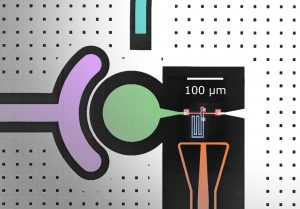A superconducting qubit used as an ultra-sensitive sensor in the radio-frequency domain
 A LKB team has demonstrated an unprecedentedly low-frequency superconducting “fluxonium” qubit, which could facilitate experiments that probe macroscopic quantum phenomena.
A LKB team has demonstrated an unprecedentedly low-frequency superconducting “fluxonium” qubit, which could facilitate experiments that probe macroscopic quantum phenomena.
The superconducting transmon qubit1 is a particular kind of chip-based qubit commonly used in quantum computing. It typically operates at frequencies in the range of billions of hertz, akin to 5G cell phones. A microwave signal at such frequency excites transitions between qubit states and allows for its control. A collaboration between the LKB’s Optomechanics and Quantum Measurement team, LPENS, CEA and INRIA has introduced a novel low-frequency alternative. Operating at 1.8 million hertz (MHz), it marks the lowest frequency ever achieved for a superconducting qubit. The potential of this qubit to directly interface with mechanical resonators vibrating at similar frequencies, enables investigations of macroscopic quantum phenomena.aniques vibrants à des fréquences similaires, permettant ainsi d’explorer des phénomènes quantiques à l’échelle macroscopique.
The implemented approach consists in using a fluxonium qubit, previously demonstrated with a frequency of 14 MHz in 2021. The fluxonium qubit comprises a loop of hundreds of Josephson junctions2, with the two qubit states corresponding to clockwise and counterclockwise currents in the loop. The transition frequency is governed by the magnetic field strength threading the loop.
Lowering the operation frequency of the fluxonium qubit posed challenges due to environmental thermal noise and magnetic field fluctuations, which could compromise its quantum properties. To address this, the team employed a cooling technique inspired by cold-atom systems and adjusted the magnetic field to induce “Schrödinger-cat” states in the qubit, known for their resilience against magnetic field fluctuations. Through this method, they achieved a tenfold reduction in the qubit’s operating frequency. Moreover, experimental results demonstrate the qubit’s exceptional sensitivity as a charge sensor, capable of detecting minute quantum fluctuations in a membrane.
These results are published in Physical Review X
https://journals.aps.org/prx/abstract/10.1103/PhysRevX.14.011007
1 The transmon qubit is a superconducting electrical circuit composed of a nonlinear inductance (a very small Josephson junction2), meaning its impedance depends on the current, associated in parallel with a large-capacity capacitor.
2 In the field of superconducting circuits, the Josephson junction acts as a potential barrier for electrons, through which they can pass via tunneling effect. It consists of two superconducting layers separated by an insulating oxide layer. Depending on the chosen parameters, it can behave like linear or non-linear inductance.
